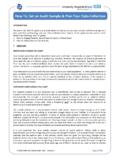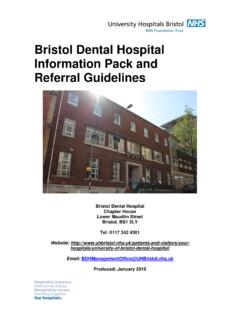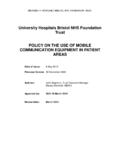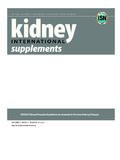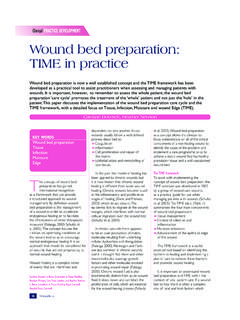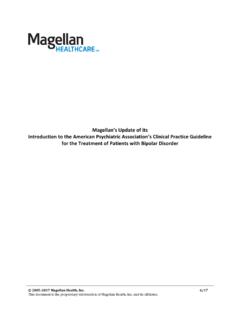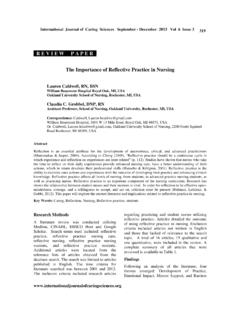Transcription of Principles for Best Practice in Clinical Audit
1 PrinciplesforBestPracticeinClinicalAudit Radcliffe Medical PressRadcliffe Medical Press Ltd18 Marcham RoadAbingdonOxon OX14 1 AAUnited Radcliffe Medical Press electronic catalogue and online ordering sales to anywhere in the world.#2002 National Institute for Clinical ExcellenceAll rights reserved .This material may be freely reproduced for educational and not forprofit purposes within the NHS .No reproduction by or for commercial organisationsis permitted without the express written permission of Library Cataloguing in Publication DataA catalogue record for this book is available from the British 1 85775 976 1 Typeset by Aarontype Ltd, Easton, BristolPrinted and bound by TJ International Ltd, Padstow, CornwallContentsContributing authorsivAcknowledgementsvForewordviClin ical Audit in the NHS: a statement from the NationalviiiInstitute for Clinical ExcellenceIntroduction: using the method, creating the environment1 Stage One: preparing for audit9 Stage Two: selecting criteria21 Stage Three: measuring level of performance33 Stage Four: making improvements47 Stage Five: sustaining improvement59 Appendix I: glossary69 Appendix II: online resources for Clinical audit73 Appendix III.
2 National Audit projects sponsored by the93 National Institute for Clinical ExcellenceAppendix IV: further reading97 Appendix V: key points and key notes101 Appendix VI: checklists105 Appendix VII: approach to examining Clinical Audit during a clinical115governance review used by the Commission for Health ImprovementAppendix VIII: recommendations from theReport of the Public119 Inquiry into Children s Heart Surgery at the Bristol Royal In rmary1984^1995(2001) and the Government s response (2002)Appendix IX: lessons learnt from the National Sentinel Audit125 ProgrammeAppendix X: list of desirable characteristics of review criteria131 Appendix XI: review of the evidence133 Index191 Contributing authorsRoyal College of Nursing20 Cavendish SquareLondon, W1G 0 RNRoss Scrivener, Information Manager,Quality Improvement ProgrammeRCN InstituteRadcliffe InfirmaryOxford, OX2 6 HEClare Morrell, Senior Research and Development Fellow,Quality ImprovementProgrammeClinical Governance Research and Development UnitDepartment of General Practice and Primary Health CareUniversity of LeicesterLeicester General HospitalGwendolen RoadLeicester, LE5 4 PWRichard Baker, Professor and DirectorSarah Redsell, Senior LecturerElizabeth Shaw, Research AssociateKeith Stevenson, LecturerNational Institute for Clinical Excellence11 StrandLondon, WC2N 5 HRDavid Pink, Audit Programme DirectorNicki Bromwich.
3 Audit Development ManagerAcknowledgementsThe preparation of this book was funded by the National Institute for Clinical Excel-lence .We would like to thank Steve Barrett and Paul Sinfield formerly of CGRDU,Leicester, for assistance in the early stages of the literature review, and Laura Price,for her work in editing the text of the book .Finally, we thank all those too numerousto mention by name who reviewed the book during its time has come for everyone in the NHS to take Clinical Audit very less would miss the opportunity we now have to re-establish the confidenceand trust upon which the NHS is and professional belief in the essential quality of Clinical care has been hithard in recent years, not least by a number of highly public failures .We can no longerthink about effectiveness of care as an isolated professional matter . Clinical govern-ance is the organisational approach for quality that integrates the perspectives of staff,patients and their carers, and those charged with managing our health service.
4 But realcommitment is needed from everyone involved if governance is to fulfil its about the quality of NHS care have attracted national publicity, publicinquiries and a focus on failure .While we must do everything we can to put in placesystems to avoid such failings in future, these isolated cases should not dominate ourthinking about quality of care .It is just as important that Clinical governance shouldsupport a process of continuous quality improvement throughout the Audit is at the heart of Clinical provides the mechanisms for reviewing the quality of everyday care provided topatients with common conditions like asthma or builds on a long history of doctors, nurses and other healthcare professionalsreviewing case notes and seeking ways to serve their patients addresses quality issues systematically and explicitly, providing reliable can confirm the quality of Clinical services and highlight the need for book provides clear statements of principle about Clinical Audit in the NHS.
5 Theauthors have reviewed the literature concerned with the development of Audit overrecent years, and are able to speak about Clinical Audit with considerable often in the past local and national Clinical audits have failed to bring aboutchange .TheReport of the Public Inquiry into Children s Heart Surgery at the BristolRoyal Infirmary 1984 1995(2001) provides salutary reading for anyone in the NHSwho is still inclined to dismiss the importance of Clinical Audit .But Audit cannot beexpected to bear fruit unless it takes place within a supportive organisation committedto a mature approach to Clinical quality Clinical Audit does not provide a straightforward or guaranteed solution for eachproblem .Local Audit programmes in primary and secondary care will need to use theprinciples set out in this book to devise and agree local programmes tailored to addresslocal issues.
6 Nevertheless, we hope you will find that the distillation of evidence andwisdom about Audit presented in this book will help you to create Audit programmesthat are capable of bringing about real National Institute for Clinical Excellence and the Commission for HealthImprovement will each have an important part to play in setting the national contextwithin which the NHS addresses the need to review the quality of healthcare .But thereal worth of Clinical Audit will depend on the commitment of local NHS staff andorganisations .We hope that this book will help provide a framework for Clinical auditthat maximises local enthusiasm and commitment to high-quality patient Deirdre HineSir Michael RawlinsChairChairmanCommission for Health ImprovementNational Institute for Clinical ExcellenceFOREWORDviiClinical Audit in the NHS:a statement from the NationalInstitute for Clinical ExcellenceThe Clinical Audit challenge facing the NHSThe NHS needs to change its approach to Clinical Audit , and this book sets out theprinciples that should guide those have been significant shifts in society s attitude to quality in healthcare overrecent years, culminating in the introduction of Clinical governance for the part of local arrangements for Clinical governance, all NHS organisations arerequired to have a comprehensive programme of quality improvement activity thatincludes clinicians participating fully in Audit .
7 Clinical Audit is the component of clin-ical governance that offers the greatest potential to assess the quality of care routinelyprovided for NHS users Audit should therefore be at the very heart of Clinical gov-ernance Clinical Audit to become an important component of how we manage our healthservices a very real change needs to take place in the standing of Audit programmeswithin the NHS . Audit can no longer be seen as a fringe activity for enthusiasts within Clinical governance, the NHS needs to make a commitment to support Audit asa mainstream needing attentionIn this book the authors set out two key areas for attention if Audit is to play a part inbringing about real improvements in quality of care .First, efforts must be made toensure that the NHScreates the local environmentfor Audit .Second, the NHSneeds to make sure that ituses Audit methodsthat are most likely to lead to auditprojects that result in real improvements.
8 Both areas deserve serious attention at alllevels in the NHS and Audit programmes are unlikely to be successful if NHS stafffind themselves struggling with Audit in the absence of appropriatemethodsand mixed record for auditClinical Audit has a mixed history in the NHS, and for every success story there arejust as many projects that have run into the ground without demonstrating anysignificant contribution to quality of services .Many of Audit s early adopters have lostthe enthusiasm they once had .This legacy needs to be addressed if individuals andteams are to re-engage their hearts and minds in Clinical Audit projects have floundered as a result of poor project design .Problemswith Clinical data have been particularly common .Data have often been of poor qualityand inaccessible, or alternatively have been collected because of administrativeconvenience even where they are not accepted as relevant measures of Clinical many cases the dataset has been simply too large to be workable within a busyclinical service weighed down with other projects have been poorly managed, inadequately carried out, or in complex healthcare systems cannot be brought about simply by the analysisof data that indicate that care might be less than perfect.
9 The management of change isoften more challenging than the Clinical issues addressed by Audit , but all too often thechange agenda has been left in the inexperienced hands of junior staff, withoutappropriate projects that may have been well designed have taken place without anytangible senior support and commitment .This has made the conduct of Audit an uphillstruggle as enthusiastic teams find their ambitious plans thwarted by many cases Audit projects have failed to emphasise in their plans the need todevote just as much attention to changes that need to flow from Audit as they havegiven to data collection and analysis .The failure to follow through Audit towardsimproved Practice has sometimes been the result of design problems, sometimes lackof senior support and commitment .In both cases healthcare staff rapidly lose theirenthusiasm when they are unable to see benefit for their patients from the considerableextra commitment needed to mount a worthwhile Audit this mixed record, there have been significant successes for Clinical local projects have provided a systematic structure through which Clinical teamshave been able to deliver real improvements in patient care.
10 In some cases nationalprojects have been able to play an important role in service-wide changes in care,bringing improved access and quality of care throughout the country (the nationalaudit of stroke care is perhaps the most well known of these).So recent experiences of Clinical Audit give good reason to believe that Audit can bemade to work but the NHS must use well-foundedaudit methodswithin Audit IN THE NHSixIntroduction:usingthemethod,creatin gtheenvironmentWhat is Clinical Audit ? Clinical Audit is a quality improvement process that seeks to improve patient careand outcomes through systematic review of care against explicit criteria and theimplementation of change. Aspects of the structure, processes, and outcomes of careare selected and systematically evaluated against explicit criteria. Where indicated,changes are implemented at an individual, team, or service level and further moni-toring is used to confirm improvement in healthcare definition is endorsed by the National Institute for Clinical is this book for?

